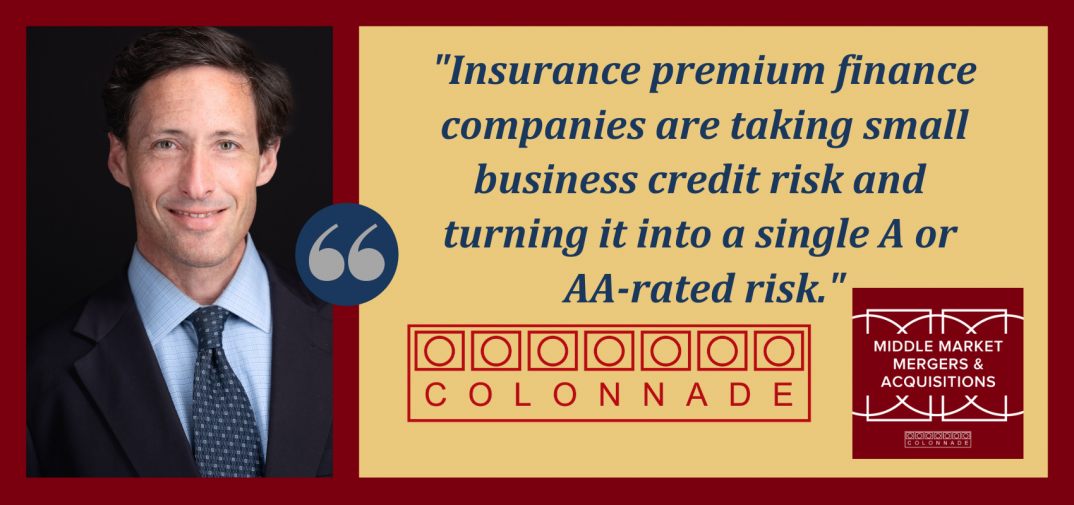This episode continues our series of “industry spotlights,” focusing on specific trends and opportunities in middle-market M&A transactions. Previous episodes include Home Warranty, Vehicle Service Contract Administrators, and Automotive Reconditioning.

Our first episode in this series is all about an exciting niche industry ($35 billion) that Colonnade has dominated in the role of advisor to both buy-side and sell-side clients. This industry focus has allowed us to deeply know the industry players and provide exceptional service to clients who hire us to assist them in a transaction.
In this episode, we answer the following questions:
- What is the Insurance Premium Finance industry?
- Why are Insurance Premium Finance companies attractive to buyers?
- How has the Insurance Premium Finance industry changed over time?
- What are some of the key drivers of valuation for Insurance Premium Finance companies?
- How can Insurance Premium Finance companies differentiate themselves in the market?
- Is there a sweet spot in terms of loan size and yields for high-value Insurance Premium Finance businesses?
- What advice would you give to owners of premium insurance finance companies to get them ready to go to market?
- How are insurance premium finance companies valued?
What is the Insurance Premium Finance industry? (00:45)
Jeff Guylay: It’s a subset of the much broader Commercial Finance industry and Specialty Finance industry. Insurance premium finance, on the commercial side, allows small businesses to finance their annual P&C insurance premiums. Everybody has to have insurance, but sometimes small businesses don’t always have the cash available to make their annual policy premium payments. Insurance premium finance provides a great service to the insurance agent, to the insured (borrower), and to the insurance carriers.
Jeff Guylay: Colonnade has studied the insurance premium finance market for the last 20+ years. We have worked on 25+ M&A transactions on the buy side and the sell side. We have gotten to know the industry players, the folks in the business, and the folks who would like to get into the business. We helped a number of our clients over the years either enter the industry or divest some of these businesses from other larger corporations.

Why are Insurance Premium Finance companies attractive to buyers? (4:00)
Jeff Guylay: It’s a very profitable business. It’s a great form of secured lending. Insurance premium finance provides a valuable service where the finance company can step in to provide funding and manage the billing and collecting. They send out invoices, track payments, and importantly, fund the premium upfront.
The beauty of this industry is that the lenders are secured by the unearned premium. The unearned premium of the policy is the piece that hasn’t been earned by the carrier. When properly structured, if a borrower stops paying off the loan, the insurance premium finance company can cancel the insurance policy (through a power of attorney) and collect the unearned premium back from the insurance carrier. Essentially, insurance premium finance companies are taking small business credit risk and turning it into a single A or AA-rated risk through the unearned premium collateral structure. On a loan by loan basis, if properly structured, there’s very little credit risk.
These businesses are valuable because insurance premium finance involves short-term loans, the loan spreads are relatively high, there’s considerable fee income, there’s meaningful growth in assets, and it’s a nice diversification play for bank buyers.

How has the Insurance Premium Finance industry changed over time? (09:20)
Jeff Guylay: Twenty years ago, this was a cottage industry in the US with about 25 meaningful players. There are still thousands of small “mom and pop” licensed insurance premium finance companies that cover small geographic regions. Over the last 20 years, there’s been a fair amount of consolidation, and most of these regional competitors have been gobbled up.
Today, if you look at the industry structure, there are only about ten significant players. There are still ~1,000 licensed companies, but there’s been considerable consolidation.
What are some of the key drivers of valuation for Premium Insurance companies? (11:00)
Jeff Guylay: Size and scale are the obvious value drivers. Like all industries, size matters (the bigger the better), and larger businesses generally trade at higher multiples.
A key value driver for this particular sector is the relationships finance companies build with the agencies. Since premium finance companies are calling on insurance agents and the insurance agents are actually the ones originating the loans on behalf of the finance companies, being in front of and being relevant and valuable to the insurance agencies is key to generating consistent loan volume. It’s the strength and the retention of the agency relationships that these finance companies build over time that is important to valuation.
How can Insurance Premium Finance companies differentiate themselves in the market? (12:26)
Gina Cocking: We had the opportunity to work with an insurance premium finance company that had a non-traditional marketing and distribution method. They were doing business via call centers (inside sales reps) to maintain solid relationships with many smaller and dispersed agencies.
Jeff Guylay: This was a unique situation where this finance company used inside sales reps (via phone) and was able to capture a large percentage of the small agency market. That coupled with excellent client service built a really good book of business.
Think about the retail insurance agency market in general, which is the group that finance companies are targeting; there are 35,000 to 40,000 independent retail insurance agents around the country. Obviously the top 100 are pretty easy to identify and visit on a regular basis, but what about the next 30,000 plus insurance agents, most of which are regional and scattered around the country. How do you efficiently direct a salesforce to visit those agents with any frequency outside of a very targeted geographic region?
Is there a sweet spot in terms of loan size and yield for high-value Insurance Premium Finance businesses? (17:00)
Jeff Guylay: A sweet spot that we’ve seen is a $25,000 average loan size. There’s enough yield in that segment to make it interesting, and there’s enough loan size to make it compelling. Companies that operate in this segment seem to be the most profitable on both a yield and dollar basis.
Most of the successful firms that we’ve worked with build a balanced portfolio. They find insurance agents that have a portfolio themselves of insured clients including small, medium, and large ticket clients. There are exceptions to this rule, which Jeff Guylay discusses at 17:35.
One former Colonnade client had done an excellent job of building a portfolio of very small ticket deals. Their median deal size was $2,500 and the company was very profitable. Through the use of technology and systems, they generated a 5% pre-tax ROA, which is about twice what the broader market commands. Colonnade sold this company to a bank through a broad auction and got great execution for our client in terms and price.
Who are the likely buyers for Insurance Premium Finance companies? (18:30)
Jeff Guylay: One obvious buyer class is industry consolidators. The most obvious example of a great industry consolidator is Imperial PFS (IPFS), the industry’s largest player. They built this business largely by acquiring many good size, well-performing regional businesses. Their blueprint for acquisitions was to have a decentralized structure and allow the regional businesses to stay in place under a branch structure. Why? Their view is that “People do business with people.” Folks generally do business with their local insurance agency, and the local insurance agency generally does business with the local premium finance company. Maintaining that personal relationship is critical. Through consolidation and superior operating systems, they are very profitable and have had great returns for their shareholder.
The second buyer class is banks. Banks love specialty finance businesses, and insurance premium finance stands out in a positive way for banks. Insurance premium finance provides short-duration assets, low credit losses, great loan spreads, consistent fee income, high growth, and diversification in terms of assets and earnings. Finally, it’s an industry that is considered pre-approved by the regulators.

An example of a bank that has played a key role in the industry is Wintrust, based in Chicago. Wintrust has one of the largest insurance premium finance companies, First Insurance Funding, which started from scratch in the 1990s. The P&C side of that business is several billion dollars of assets and is a real machine. One of the important things that they did was spend time with the regulators, educating them over the years about what a great business insurance premium finance is, why it is a safe asset class, and why it’s a good business to be lodged within a bank. From Wintrust’s perspective, this was an opportunity to build franchise value independent of the bank. You can characterize Wintrust as an exceptional deposit gathering franchise that has a number of specialty finance businesses. They’ve been able to demonstrate to other banks that insurance premium finance is a great asset class with consistent performance.

What advice would you give to owners of premium insurance finance companies to get them ready to go to market? (27:30)
Jeff Guylay: Be “bank ready”, which is all about systems, processes, and documentation. Make sure you’re on a name-brand loan management system, like Input1. Make sure you have the systems and processes in place so that you can demonstrate to the legion of folks that are going to come in for due diligence that you’ve got processes in place. Being bank ready is about being able to be a part of a larger financial institution that’s regulated.
The next piece would be to demonstrate your plans to grow the business. If you’re a business with a $25 million portfolio and you want to sell to a bank of meaningful size, you’re going to have to demonstrate that you can grow considerably to make this a meaningful acquisition for the bank. What’s the growth plan? How are you going to get there? Who are you going to hire on the sales side? How do you differentiate yourself in the market?
How are insurance premium finance companies valued? (30:00)
Jeff Guylay: When we look at insurance premium finance businesses, we look at the size, capitalization, the profile of the assets, and the income statement. We look at the yields, the rates from the borrowers, fees, losses, and operating expenses.
In general, we see premium finance companies generate a 2% to 4% pre-tax ROA. We look at the return profile over the history of the company.
There are three key metrics that we often use to triangulate valuation. They are, in order of importance (from least to most important):
1) multiples of book value,
2) the premium that a buyer is willing to pay as a percentage of the net receivables, which can range from 10% to 25%. (In layman’s terms, what value would a third party put on originating these loans? What could you buy it for in the market?), and, most importantly,
3) the multiple of pre-tax income.
Interest expense is key. When presenting a company to a potential buyer, we can often recast the numbers to tell a different story if the company is borrowing at a different rate (which can happen when a company is purchased by a bank).
All of the above impact valuation, but I’ll say again that higher growth businesses generally command higher multiples.
Finally, there’s also a scarcity value premium today. Twenty years ago, there were lots of opportunities for acquisitions, and multiples were lower. In the current market, because of all of the recent consolidation, there aren’t that many sizable players left that come up for sale with any frequency. This dynamic can drive up the multiple in a competitive auction process.
If you are in the premium insurance finance industry and are considering a transaction, please contact us so that we can help you think through your next steps.
For more on the insurance premium finance industry, read Colonnade’s published white paper here.





